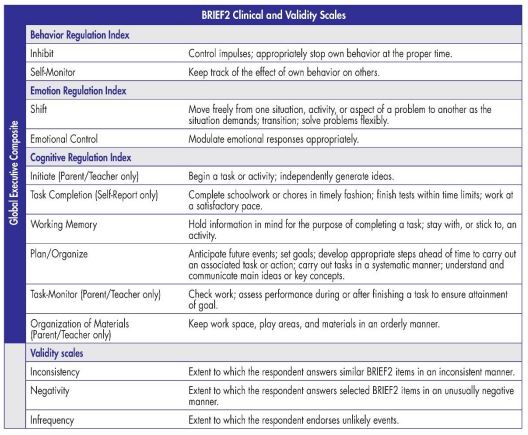Details
Purpose
Screens for executive function impairment in ages 5–18 years (parent & teacher forms) & 11–18 years (self-report form)
Authors
Gerard A. Gioia, PhD, Peter K. Isquith, PhD, Steven C. Guy, PhD, and Lauren Kenworthy, PhD
Administration Formats
Additional Details
The Gold-Standard Rating Form for Executive Function Testing
The BRIEF2 gives you the information you need to help children and adolescents with executive dysfunction. It digs deeper than similar measures and pinpoints exactly where and why children struggle, so therapists and schools can make informed and impactful intervention and accommodation recommendations.
It is designed for a broad range of children for whom there may be concerns about self-regulation, such as those with autism spectrum disorder (ASD); learning disabilities (LD); attention disorders; traumatic brain injuries (TBI); depression; and other developmental, neurological, psychiatric, and medical conditions.
Expand all Additional Details
- Saves time: Administer in just 10 minutes; online administration and scoring is also available.
- Comprehensive: Includes information about executive functioning and ADHD in one test. Features increased sensitivity to executive function problems in key clinical groups such as ADHD and ASD.
- Cohesive: Parallel structure across forms allows for more informed and effective interventions.
- Trusted: The center of more than 1,000 peer-reviewed studies in 60 languages across six continents.
Features and benefits
- Three indexes (behavioral, emotional, and cognitive).
- The infrequency scale helps identify unusual responses.
- The Score Report's overview section provides important information at a glance, including validity results, index T scores and percentiles, and explanatory text about the child's or adolescent's overall profile. The report includes a score summary table, score profile, and item response table.
- The Interpretive Report includes all information on the score report PLUS interpretive text for BRIEF2 clinical scale, index, and composite scores and validity indicators.
- The Parent/Teacher form includes an optional ADHD score profile, interpretive text, and DSM-5 ADHD Symptom Checklist. It contains 63 items within nine theoretically and empirically derived and well-validated clinical scales that measure commonly agreed upon domains of executive functioning: Inhibit, Self-Monitor, Shift, Emotional Control, Initiate, Working Memory, Plan/ Organize, Task-Monitor, and Organization of Materials.
- The Self-Report provides additional details about the level of awareness and perceptions of the examinee’s own executive functioning. It contains 55 items within seven theoretically and empirically derived and well-validated clinical scales that parallel the Parent and Teacher forms: Inhibit, Self-Monitor, Shift, Emotional Control, Task Completion, Working Memory, and Plan/Organize.
- Parent and Self-Report forms are available in Spanish.
- A free training course is available on the PAR Training Portal
Available in Spanish
Administer the BRIEF2 Parent and Self-Report Forms to your Spanish-speaking clients via PARiConnect.
Collapse all Additional Details
